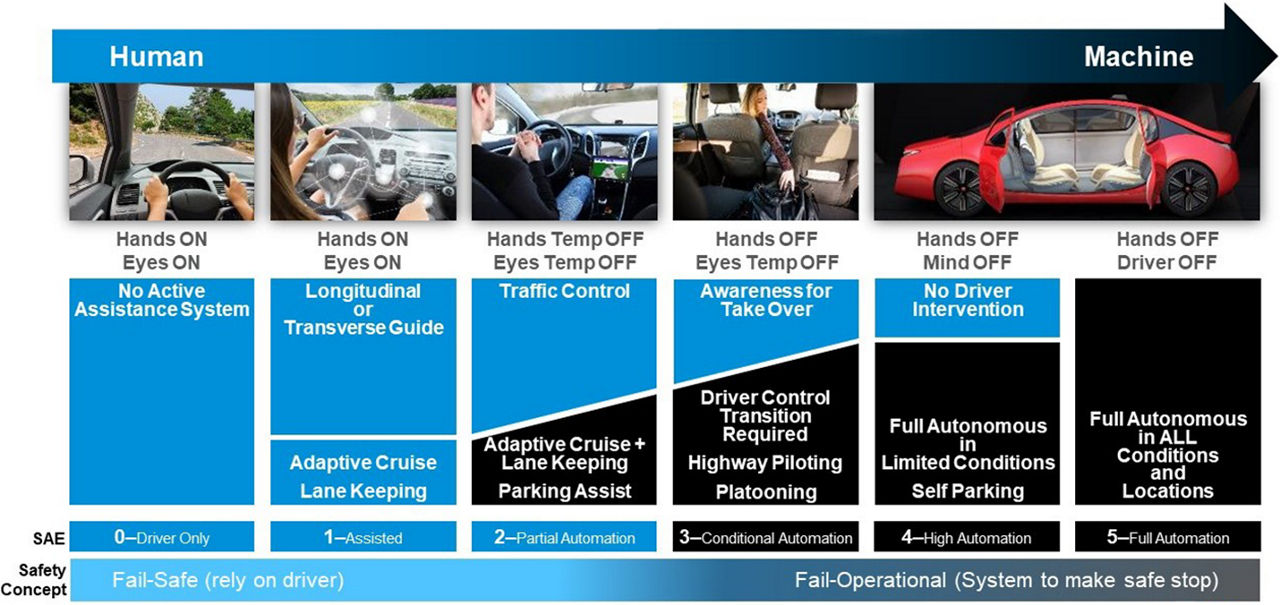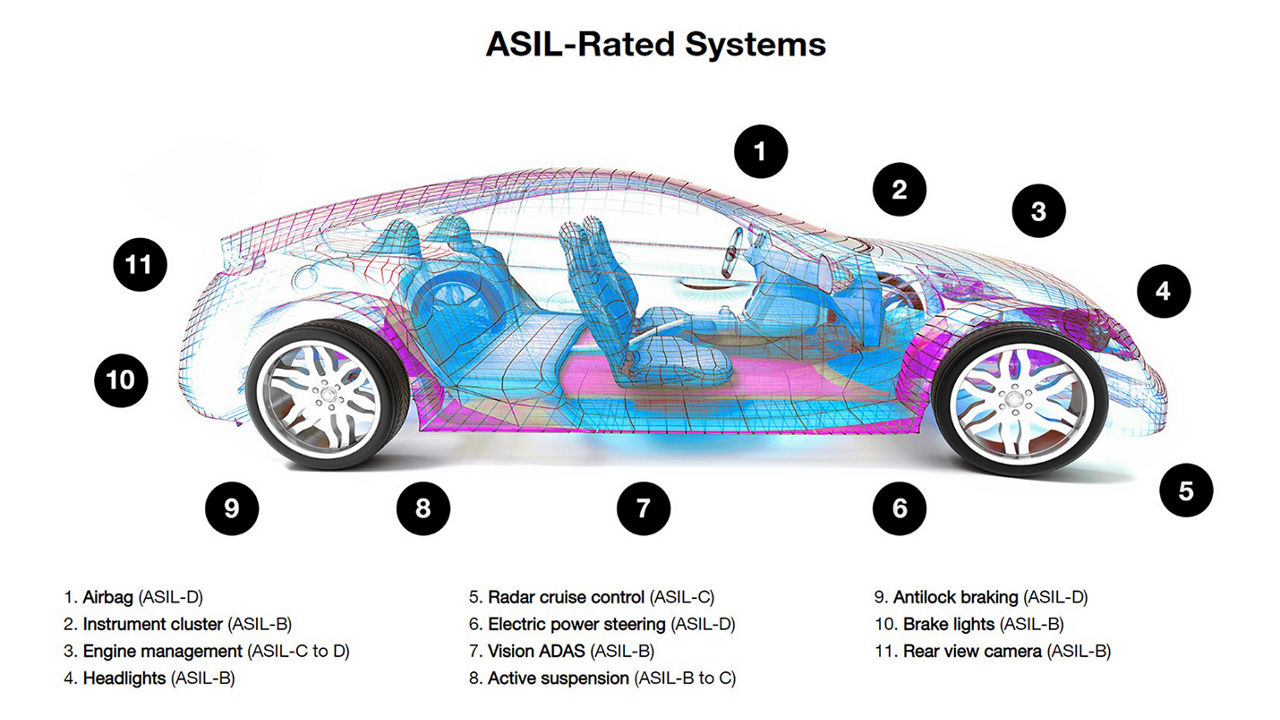Sitting back and letting your autonomous car drive you to work may still be a couple of years away, however automotive OEMs are rolling out advanced driver assistance systems (ADAS) applications that play a key role in helping the driver make safer driving decisions. As a consumer, I love having the extra protection and notification of what is happening around me and once I get used to driving a car with these features, it is almost impossible to go back to a car without them.
To realize the vision of a self-driving vehicle, there is a wide range of complex, state-of-the-art technologies that need to come together seamlessly and operate flawlessly over the lifetime of the vehicle. Across the board, whether they are revolutionary sensor technologies that are fused together to realize perfect “vision,” or computing platforms that are in excess of thousands of tera operations per second (TOPS) of compute performance, the technology that is required to create the fully functional self-driving car is some of the most demanding across any market segment.
The demands on memory and storage performance to achieve this breakthrough is no exception. Level 2+ and Level 3 ADAS functionality is driving the need for 256-to-512-bit memory bus widths of LP5X that operate at an I/O signaling rate of 8.5Gbps. And while the overused tagline of “data center on wheels” has run its course – self-driving cars really do require best in class, data-center performance, reliability and safety. Therefore, Micron introduced SAFER automotive memory that provides unique capabilities for functional safety with engineering leadership and random and systematic fault coverage. This SAFER framework provides guidance when considering breakthrough automotive memory solutions and support.
At the core of extreme reliability and overall system integrity, there has been increased focus on the different elements of a given system and the impact on overall functional safety. With software footprints expected to expand from 100 million lines of code in today’s high-end vehicle to something on the order of 1 billion lines of code in the future, automotive memory has moved from the back seat to the front seat in terms of importance.
With more than 30 years of memory and storage experience in the automotive market, Micron recognized the role of memory would play in addressing the increased complexity of functional safety. Functional safety will be critical to the realization of autonomous vehicles.
Micron has made significant investments in functional safety technology and processes to ensure that, as the leading memory and storage supplier to the automotive industry, we will supply best-in-class products that are designed with the most stringent safety requirements in mind. At Micron, this process starts from the very beginning of the product. As such, we are proud of holding the unique distinction of being the safest memory currently in the industry. As we look across the safety capabilities that we deliver, we recognize that Micron solutions are the SAFER solutions in the industry.
Levels of Autonomy and Safety Concept
FuSa Enables Autonomous Vehicles
 Figure 1: Infographic of autonomy systems' levels from Human-centric to Machine-machine
Figure 1: Infographic of autonomy systems' levels from Human-centric to Machine-machine
Given the impact these systems have over the control of vehicles, it is important that all the components that go into these systems meet the strictest quality and safety standards. The ISO 26262 standard has established the ASIL (automotive safety integrity level) standard which ranges from A to D to specify the requisite safety level of the various systems within the vehicle. ASIL A is the lowest designator and ASIL D is the highest. To put things into perspective, 1 FIT means there is 1 failure in 1 billion operating hours of the component. This means that the product of the number of devices and their operating hours should be 1 billion. So, the FIT rate can be the number of failures in 1 million devices for 1000 operating hours or 1000 devices for 1 million hours.
Typical Automotive ASIL Classifications
 Figure 2: ASIL-Rated Systems
Figure 2: ASIL-Rated Systems
Micron is the world leader in automotive memory and works closely with our customers to understand ISO requirements and we recently introduced LPDDR5 Micron SAFER Automotive memory - the industry’s first ASIL-D LPDDR5 compliant memory.
Micron defines SAFER Automotive memory as:
S = Safest Solution in the Industry Currently Available
- Industry’s first ISO 26262 ASIL D-compliant memory
- Micron Safety Office for management of company-wide ISO 26262 processes
A = Automotive Mindset
- Over 30 years of commitment to the automotive industry
- Automotive leadership - DRAM, NAND, NOR capabilities: FuSa (functional safety), security
F = Fault Coverage
- ASIL D systematic fault coverage—safety elements for random fault coverage
- Real-time fault detection, captures Top Level Failure Mode (TLFM), data corruption, addressing, lost data
E = Engineering Leadership
- Architecture team works closely with OEM customers to optimize Micron memory to their system design
- 13 dedicated engineering labs worldwide to support customers in the early stages of their design and then during bring up to ensure the fastest time to market with the lowest risk
R = Risk Management
- Reduced memory integrator support, highest level safety assurance
- Complete set of safety related documents, customer support in safety analysis
Micron continues to raise the bar by striving for quality memory standards for automotive, which are defined as: …a measure of excellence or a state of being free from defects, deficiencies and significant variations….1 Micron SAFER automotive memory is striving for: the absence from risk due to hazards caused by the failure of E/E systems during operation… to improve safety, detect faults and control failure … i.e.,. remove or eliminate uncertainty. 2
1. Detect and control can be at supplier level or system integrator level.
2. Based on ISO 26262 documentation
The Micron SAFER automotive memory blog series
This series provides insight and guidance when considering breakthrough automotive memory solutions and support. SAFER incorporates five key concepts: (S) Safest solution currently available in the industry, (A) Automotive mindset, (F) Fault coverage, (E) Engineering leadership and (R) Risk management. Each letter associated with the acronym SAFER has a corresponding blog with associated content. Check Micron’s functional safety page for info on additional blogs: Functional Safety for Automotive | Micron Technology, Inc.
